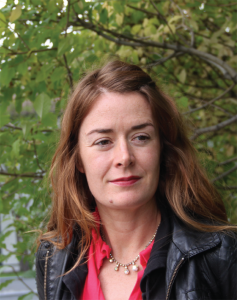Northern Tenacity
Love her or hate her, Genesee Keevil of the Yukon News stands as an example of how the North should cover the North: fearlessly

Right away, her editor saw Keevil’s “crazy, raw talent.” She earned her reputation as a crusader by tackling stories other reporters won’t touch
Five years ago, three Yukon News reporters held a meeting tosee who would cover which political party on election night. Genesee Keevil, who had been at the News for two years, drew the right-of-centre Yukon Party. It wasn’t the short straw. She wanted the assignment, as did others. When she arrived at the conference room of Whitehorse’s High Country Inn, it was calm and almost empty. But as more people showed up, things changed. While party supporters watched the favourable results come in, some yelled and harassed the reporter. Someone suggested she should be shot; another was surprised her editor, who had written an editorial calling on voters to reject the Yukon Party, was still alive. A woman followed her around, interrupted her interviews and grabbed her by the arm. Another ushered potential interview subjects away from her. A man asked the crowd, “Who is the loneliest person in the room?” while waving a beer bottle through the air. Others joined in the mockery. Another person told her to go home.
She stayed. And the next day, she wrote a news story about the election, which the Yukon Party won. Then, after lots of thought and debate, editor Richard Mostyn and an apprehensive Keevil decided to tell the rest of the story. She was reluctant, she says, because she believes it isn’t a journalist’s job to put herself into stories. Mostyn says now: “She did not want to get into any of the nonsense that happened that night. She wanted to be bigger. I admire her immensely.” In a “situational” (a first-person article based on the writer’s experiences) titled “Good Thing They Didn’t Lose,” she wrote: “For three hours I’d been yelled at, heckled, shoved and sprayed with spit. They’d tried to intimidate me, and delivered their threats.” The revelations generated a flood of letters and calls critical of the Yukon Party, and forced an apology from then-Premier Dennis Fentie.
Much of the election night outrage was over Mostyn’s editorial, but it was no fluke that Keevil was the reporter at the centre of it. She’s made plenty of enemies and sold lots of papers while working at the News. She writes stories on troubling topics such as mental health, homelessness and addiction that other reporters don’t bother with, don’t have time for or don’t want to touch. She has also faced criticism for not doing her homework or for writing one-sided stories. But she continues to uncover uneasy truths, regardless of the consequences. Balancing hard-nosed, big-city journalism with a small-town sense of community is difficult and it’s no surprise that everyone in town has an opinion about her, but Keevil’s work stands as an example of how the North should cover the North: fearlessly.
Until she was seven, Keevil lived without electricity or running water on a farm just outside Powassan, near North Bay, Ontario. After high school, she studied philosophy and literature at McGill University in Montreal. Later, she mushed dogs full time in Finland and played in what she calls “a cartoon punk band” (they wore crazy costumes, space helmets with stars on them and capes) in Taiwan. Then, as a wilderness guide, she led 40-day Ontario canoe trips. After spending a few years drifting between Ontario and British Columbia, Keevil headed to Whitehorse to work as a wilderness guide, which meant leading canoe trips in the summer, mushing dogs in the winter and starting a dog team of her own. Her team consisted mostly of rescued sled dogs that mushers planned to kill. The 35-year-old, who is tall with long reddish-brown hair, now lives off the Alaska Highway at a place called Squatters’ Row, a small neighbourhood fighting to separate from the city. One of her 19 sled dogs has no eyes, so it can’t run with the team in public events such as the Quest 300, the first leg of the Yukon Quest, a 1,000 mile race from Whitehorse to Fairbanks, Alaska, but he practises with the rest of the team.
Yukon’s population boomed during the Klondike Gold Rush in the late 1800s, but today there are only about 27,000 people in Whitehorse and 35,000 in the entire territory. It is a place where people get to know each other. However, a small population in an area roughly the size of Texas can make it hard for journalists to understand and report on what happens in the smaller communities. Many towns struggle with political corruption, homelessness, substance abuse and environmental degradation by mining companies, but each is different.
Whitehorse has two English papers: The Whitehorse Star and the Yukon News. The Star comes out Monday to Friday, with a circulation of 2,400. The News comes out just twice a week and sells 6,300 copies on Wednesdays and 8,400 on Fridays. The city also has a cbc North station and two independent radio stations, as well as a bi-weekly arts magazine called What’s Up Yukon. Jim Butler, who has worked at the Star for 30 years, is the long-time editor of the 111-year-old publication. “We try to be a paper of record,” he says. Sitting in his crowded office, surrounded by books, papers and clippings, he says the News has a talented staff and has earned a reputation for breaking big, uncomfortable stories. One 2003 sensational scoop, for example, revealed Fentie’s past as a heroin dealer. The News dug up old Edmonton Journalarticles to reveal police had charged him with two counts of trafficking heroin in the 1970s. After serving 17 months in a federal penitentiary, he was released and received a federal pardon, sealing his records from public inspection. “You’ve got to give them credit,” Butler says of his competitor. “It was a major achievement.”
When Mostyn started working at the News in the late ’80s, he and his colleagues wanted to treat Whitehorse as the capital city it is—not a small town. But it took a while for the community to grow accustomed to an upfront reporting style that didn’t hold back. Showing photos of accident victims or following the money trail, for instance, didn’t sit well with the community. Sometimes 450 complaint calls would light up the switchboard on Friday afternoons. Publisher Stephen Robertson stood by his staff and the anger eventually subsided. But people still complained about the paper—particularly its fiery editorials—when Keevil waltzed into the newsroom in 2003. She asked to write a story. And though her only journalism experience was writing monthly youth columns for her local paper and editing her high school paper, Peter Lesniak, the editor at the time, tossed her an assignment. Mostyn, who would become editor in 2005, witnessed her “crazy raw talent.” She freelanced before getting on full time, and soon enough, Keevil discovered she had a knack for getting information out of people.
Chris Ouellet had been selling drugs out of his house for 20 years. People in Whitehorse knew who he was, but no journalist had interviewed him. So Keevil repeatedly knocked on the door of his house in the shade of the clay cliffs in the older part of downtown. She didn’t tell anyone—not even Mostyn—because she was worried he wouldn’t want her to do it alone. Day after day, the voice inside the house told her to go away. Then, after several months, someone told her to enter and she let herself in. Ouellet was lying on a bed, fully clothed, in a room with drawn curtains. In her flip-flops, Keevil stepped around the used needles that littered the floor, sat down and started talking to Ouellet, making sure he wasn’t totally out of it. He told her about everything, from his childhood to how he became so successful in drug dealing. Then she called a photographer at the office and said, “Don’t tell anyone. I’m at 810 Wheeler.”
After the News published “Making Tracks at 810 Wheeler,” in which Ouellet boasted of how much money he made (up to $4,000 a day) and how he’d done cocaine with RCMP officers, readers reacted immediately. Many people wrote emotional letters to the editor claiming Keevil had glorified a dealer and angry parents made sure not to leave the paper on the coffee table. An out-of-uniform cop confronted her at the News and told her to stop what she was doing with the Ouellet story. (She wasn’t intimidated. “I towered over him,” she says, smiling.) But a few readers argued it was a story that needed to be told. Some even wrote to Keevil personally. And the Canadian Community Newspaper Association, which represents 700 English-language papers, considered it the best Canadian feature written in its circulation class in 2007.
Keevil gets most of her story ideas by talking to people. When someone told her about 70-year-old Mabel Peterson, who lived down by the clay cliffs under a tattered and damp tent, she went to find her. Peterson had lost everything, including her residential school settlement from the federal government, but after her story ran, she reunited with her family. In November 2010, Keevil wrote a story called “Into the Wild, Downtown Whitehorse” about a 51-year-old man named Allen Kempel, who came to Yukon with his dog Bandit. He wanted to live off the land and ended up living near the clay cliffs in an old school bus, with seven puppies, hunting for firewood in the winter. Keevil wrote: “The job search is tougher because Kempel smells like his bus—creosote, tanned leather and a little bit like puppy.”
Along with these human-interest pieces, Keevil continued tackling controversial issues. Often, she interviewed inmates of the Whitehorse Correctional Centre (WCC) for stories, but when the guards told her to interview them for their point of view, the communications department wouldn’t let her. She remembers a media relations person making a snide remark about her reporting being biased in favour of the inmates. “They’re the ones that shut it down and then say it’s biased,” Keevil says. “It’s ridiculous.” The WCC eventually introduced a media policy that made landing interviews harder for all journalists. (The inmates admire her work, though: a week after she wrote about them not having a dentist, they had one.) But the reporters who occasionally go for drinks with Keevil at the Roadhouse or the Gold Rush on Fridays weren’t happy with the policy change.
PR flacks aren’t the only ones who seldom speak with Keevil on the record. Some sources panic when they hear it’s her and hang up. She keeps trying anyway. “I’ll call them and be like, ‘Hi, it’s Genesee again’ and they’ll freak out,” she says. But other sources ask specifically for her and she hears from ex-government employees who no longer have to deal with gag orders and call to say, “I know you’ve been calling me.” And there are still those who call just to yell at her. It’s become a bit of a joke in the newsroom.
A number of Keevil’s stories involve young people. Angels Nest is a small youth centre named after a 19-year-old whose remains were found in the woods in a case, that was classified as a “suspicious death,” but remains unsolved. At the centre, a friendly tabby named Pandora jumps from sofa to sofa, looking for affection, while homeless teenagers make dinner, their art displayed on the brightly painted walls. The kids who hang out at Angels Nest have not had easy lives. Samantha Sam is one of them. Keevil wrote that she spent time in a government-run group home called 16 Klondike, was raped at age 11, started using crack at 13 and almost bit her tongue in half after taking 14 hits of ecstasy (Sam, who was 17 at the time, clarifies that she took 8 or 9 hits). Keevil’s story read, “While kids her age were in Grade 8 learning algebra and reading One Flew Over the Cuckoo’s Nest, Sam was graduating from crack, and taking ecstasy as an elective.” Sam, now 20, who has kept the story in a scrapbook, says Keevil’s lead made her laugh because it rang so true: “The smell of toast makes Samantha Sam sad.” But Sam was also taken aback by the article. “It was all political,” she says. “I sat back and thought, ‘Oh, my goodness.’” Sam was surprised to see her personal story used to illustrate the failings of the territorial government, but wanted to be open about her past, because so many people aren’t.
Angels Nest founder Vicki Durrant ran for the Yukon Party and was one of the few people who spoke kindly to Keevil on election night. She trusted her and stood by during the interview with Sam. She believes “Of Abandoned Children and Abandoned Reports” was a positive story, but admits it generated a lot of censure, anger and hurt feelings from government employees and some of the young people who lived at 16 Klondike. It called attention to an ignored territorial report on the living conditions in all group homes, including 16 Klondike. “I think the wonderful thing about Genesee is that she does bring the youth to the surface,” says Durrant, who has worked with high-risk kids for over 13 years and believes Whitehorse residents live with their heads in the sand. “People don’t want to talk about sexual abuse, people don’t want to talk about the fact that young girls are prostituting themselves, people don’t want to hear about this stuff.”
Keevil also looked into problems at a youth detox shelter. Since the emergency centre at Alcohol and Drug Services opened in early 2008, only 34 people had used it and just four had slept there at the time Keevil’s article ran in August 2011. Even though the shelter is empty most nights, it had two full-time employees who earn wages totalling $150,000 in 2010. According to Keevil’s story, “An Empty Youth Shelter Tug of War,” the problem is staff members search the kids when they arrive and then send them home early the next morning. People who advocate against this shelter consider it a waste of money and say that these youth need more than one night to deal with their problems.
That story included government sources because it was a rare example of public servants being allowed to speak to her on the record—and it took years of trying. Most of the time, though, communications departments remain uncooperative. “It’s really frustrating,” Keevil says. “It undermines your credibility a little bit.” But Katharine Sandiford, senior editor at Up Heremagazine, who works out of Whitehorse, says sometimes Keevil doesn’t give the government enough time to respond. “There’s always a message to her stories, whether they are balanced or not.”
Keevil knows some of her stories can look biased, but says she tries to get as many sides as she can. Eventually some people may talk, but only after a long time or after they quit their jobs. So she writes, sources refuse comment, she continues without their side and the cycle continues. In an effort to get out of that rut, she met with an RCMP sergeant to improve their working relationship and open the lines of communication.
Competitors aren’t impressed, though. “She isn’t afraid of criticizing the powers that be, but I do find it frustrating to read any work based on a single source,” says Justine Davidson, who until recently was a Star reporter. Davidson offers no specific examples, but Keevil’s 2008 series, “Jailed Without a Cause,” seems to fit the bill. She interviewed Veronica Germaine, a troubled WCC inmate, arguing correctional centre staff had detained the woman for two years after she’d been found not criminally responsible for her crimes due to mental disorders. Germaine, who remained in jail because there was no halfway house for women or a secure psychiatric hospital in the territory, felt she wasn’t getting the treatment she needed. Keevil consulted court documents and three government officials for the series, but many major sources declined to comment and Germaine was clearly the focus of the piece. “We’re not allowed to run a story without contacting both sides. That’s our policy,” Keevil says. “But the government often won’t comment, so it seems like I have one source.” Still, one-sided stories make for compassionate characters, and Davidson argues, “It’s a lot easier to read a really sympathetic story.”
Indeed, the series won silver in the investigative journalism category of the B.C.-Yukon Community Newspaper Association Awards. “From an outside perspective, from people who do not live in this community, who just read those 800 or 900 words, they look like pieces of really great advocacy journalism and probably sometimes that’s well deserved,” says Davidson. But reporting in a small town can be fraught. “You have to be careful because you live in the community. You’re not in Toronto. You’re not in New York City. You live with 25,000 other people and can’t go around pissing on their doorsteps.”
Meanwhile, Harry Kern, a Whitehorse photographer and Yukon Quest board member, says he’s wary of talking to reporters after an experience with Keevil. After running into her, he let it slip that a prominent board member was resigning and was shocked to see the information printed in the News. “I’m no longer a virgin anymore when it comes to media,” he laughs. “It was a sort of involuntary deflowering.”
After she wrote stories about the lack of regulation for taxis and how young women were exchanging sex for rides, a group of cab drivers gathered outside the News office and then went inside to look for her. She could hear them from her desk as they stood at the top of the stairs talking to the advertising staff. When her colleagues told them she wasn’t in, the drivers asked, “Well, when is he coming back?” Keevil, unfazed, sat at her desk. Although she’s used to people being angry with her, she was amused that they thought she was a man.
But for those who know who she is, Keevil is easy to spot. She is a colourful dresser. When folks do recognize her on the street, they either give her tips or avoid conversation altogether. Others won’t allow the News into their homes because of its stories. “I try to shake people out of their passivity,” she admits. She certainly has: she’s received two death threats.
Still, she has her fans. Durrant, for one, asks, “Can you imagine if Whitehorse didn’t have a Genesee?” Meanwhile, Sandiford praises Keevil for finding “those pretty buried stories” and points out that some of her pieces have spurred the government to make needed changes to policies and bylaws.
And there were days when Davidson opened the News and thought, “Damn, we don’t have that.”
After midnight, the Dawson City bar that Yukoners call the Pit fills up and the daylight briefly comes in each time the door opens. Patrons slow dance despite the mostly fast-paced rockabilly. Keevil, in a long and dramatic pink wig and thrift store prom dress, stands at the edge of the stage, left hand wrapped around her upright bass. The only woman in her four-person band, Sasquatch Prom Date, she dedicates a song to all the trailer park wives with too much hairspray. She later plays “I Shot Your Dog,” a cover of a Fred Eaglesmith classic, but its title could easily describe another Keevil story that created a stir: A Dawson man shot his badly neglected dogs in protest after the municipality said he couldn’t keep them. After Keevil wrote about it in 2006, the man sued the News for libel, but the case still hasn’t gone to court.
Working in Yukon means there’s certainly no shortage of colourful people for her to write about, and that’s one reason she has no interest in moving on to bigger papers, as many journalists who work in Whitehorse are so eager to do. After eight years, she’s been around longer than most other reporters and she knows the politics, the issues and the small town allegiances. And nobody denies that she is talented—not even the people who yelled at her on election night. Keevil, who is working on a master’s degree in human security and peace building, has written freelance articles for The Globe and Mail and the Financial Post and wants to explore long-form magazine writing, but she says she’s staying put for now.
Storytelling is important to her—“I try to draw people in, in a way that keeps people reading,” she says—but mostly, she takes satisfaction in improving people’s lives by holding those in power to account. She believes journalism is a vehicle for legitimate change in a community, especially a small one. And she knows she’s making a difference: The night “Making Tracks at 810 Wheeler” ran, Keevil walked into the historic Taku bar on Main Street—and received a standing ovation. “It was another one of those small town moments,” she says. “That wouldn’t have happened in Toronto.” 
Samantha Anderson was the Online Story Editor for the Winter 2012 issue of the Ryerson Review of Journalism.













































